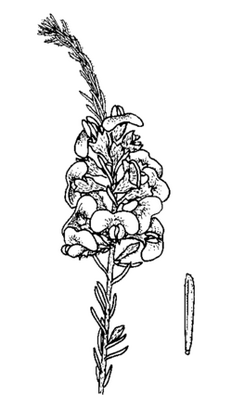Common name: Showy Parrot-pea
Dillwynia sericea A.Cunn. APNI* Synonyms: Dillwynia sericea subsp. A sensu Jacobs & Pickard (1981) APNI*

Description: Erect shrub 0.5–1 m high; stems with dense spreading or appressed hairs, especially on young branches.
Leaves linear, usually 5–20 mm long, apex usually shortly acuminate, tuberculate or smooth, glabrous or with long hairs.
Inflorescences usually 2-flowered, axillary, sessile; bracts 1–3 mm long; bracteoles 0.5–1 mm long, concave, slightly hairy along upper margins. Calyx 4–7 mm long, glabrous or hairy. Standard 8–12 mm long.
Pod 3–4 mm long; seeds reticulate.
Distribution and occurrence: Widespread in the eastern half of the state. Grows in exposed heath, woodland and dry sclerophyll forest on a variety of substrates.
NSW subdivisions: NC, CC, SC, NT, CT, ST, NWS, CWS, SWS, NWP, SWP
Other Australian states: Qld Vic.
Intermediates occur between D. sericea subsp. sericea and subsp. rudis, especially in CT and CWS where the two subspecies overlap. This complex is under revision.
Text by P.H. Weston & P.C. Jobson
Taxon concept: Flora of NSW 2 (1991)
Taxa not yet included in identification key
Dillwynia sericea subsp. Yetman (R.G.Coveny 14478),
Dillwynia sericea subsp. glabriflora,
Dillwynia sericea subsp. rudis
APNI* Provides a link to the Australian Plant Name Index (hosted by the Australian National Botanic Gardens) for comprehensive bibliographic data
***The AVH map option provides a detailed interactive Australia wide distribution map drawn from collections held by all major Australian herbaria participating in the Australian Virtual Herbarium project.
|


